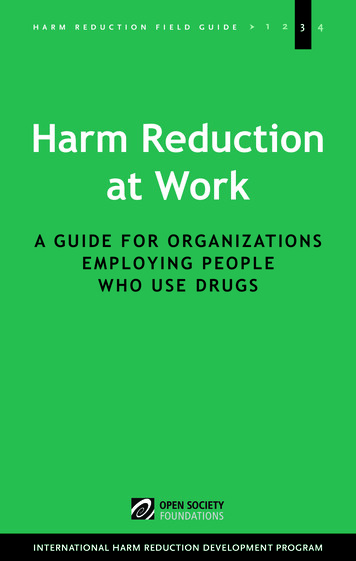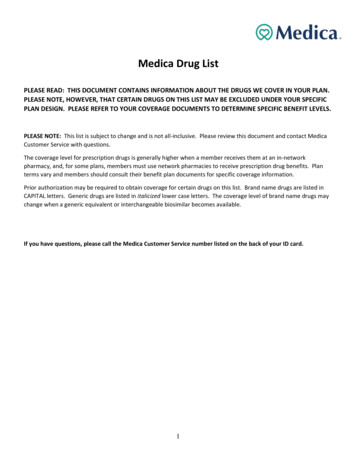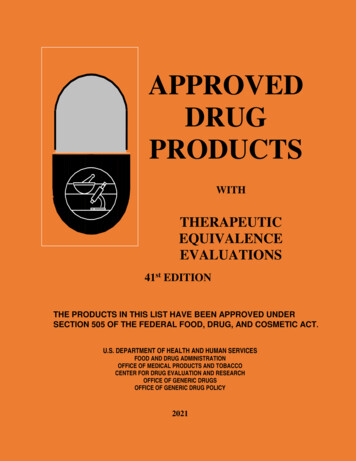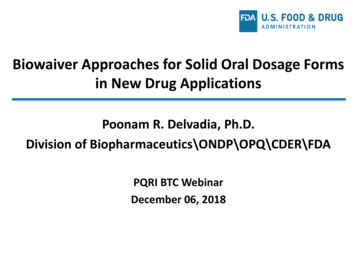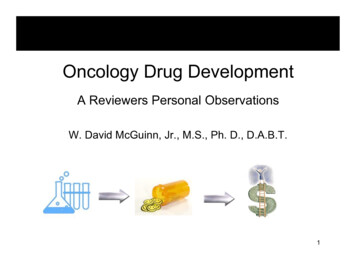
Transcription
Package InsertPage 1(No. 3826 and 7126)NEWDEPAKOTE ERDIVALPROEX SODIUMEXTENDED-RELEASE TABLETSRx OnlyBOX WARNING:HEPATOTOXICITY:HEPATIC FAILURE RESULTING IN FATALITIES HAS OCCURRED IN PATIENTS RECEIVING VALPROIC ACIDAND ITS DERIVATIVES. EXPERIENCE HAS INDICATED THAT CHILDREN UNDER THE AGE OF TWO YEARSARE AT A CONSIDERABLY INCREASED RISK OF DEVELOPING FATAL HEPATOTOXICITY, ESPECIALLYTHOSE ON MULTIPLE ANTICONVULSANTS, THOSE WITH CONGENITAL METABOLIC DISORDERS, THOSEWITH SEVERE SEIZURE DISORDERS ACCOMPANIED BY MENTAL RETARDATION, AND THOSE WITHORGANIC BRAIN DISEASE. WHEN DEPAKOTE IS USED IN THIS PATIENT GROUP, IT SHOULD BE USED WITHEXTREME CAUTION AND AS A SOLE AGENT. THE BENEFITS OF THERAPY SHOULD BE WEIGHED AGAINSTTHE RISKS. ABOVE THIS AGE GROUP, EXPERIENCE IN EPILEPSY HAS INDICATED THAT THE INCIDENCE OFFATAL HEPATOTOXICITY DECREASES CONSIDERABLY IN PROGRESSIVELY OLDER PATIENT GROUPS.THESE INCIDENTS USUALLY HAVE OCCURRED DURING THE FIRST SIX MONTHS OF TREATMENT.SERIOUS OR FATAL HEPATOTOXICITY MAY BE PRECEDED BY NON-SPECIFIC SYMPTOMS SUCH ASMALAISE, WEAKNESS, LETHARGY, FACIAL EDEMA, ANOREXIA, AND VOMITING. IN PATIENTS WITHEPILEPSY, A LOSS OF SEIZURE CONTROL MAY ALSO OCCUR. PATIENTS SHOULD BE MONITORED CLOSELYFOR APPEARANCE OF THESE SYMPTOMS. LIVER FUNCTION TESTS SHOULD BE PERFORMED PRIOR TOTHERAPY AND AT FREQUENT INTERVALS THEREAFTER, ESPECIALLY DURING THE FIRST SIX MONTHS.TERATOGENICITY:VALPROATE CAN PRODUCE TERATOGENIC EFFECTS SUCH AS NEURAL TUBE DEFECTS (E.G., SPINA BIFIDA).ACCORDINGLY, THE USE OF DEPAKOTE TABLETS IN WOMEN OF CHILDBEARING POTENTIAL REQUIRESTHAT THE BENEFITS OF ITS USE BE WEIGHED AGAINST THE RISK OF INJURY TO THE FETUS. THIS ISESPECIALLY IMPORTANT WHEN THE TREATMENT OF A SPONTANEOUSLY REVERSIBLE CONDITION NOTORDINARILY ASSOCIATED WITH PERMANENT INJURY OR RISK OF DEATH (E.G., MIGRAINE) ISCONTEMPLATED. SEE WARNINGS, INFORMATION FOR PATIENTS.AN INFORMATION SHEET DESCRIBING THE TERATOGENIC POTENTIAL OF VALPROATE IS AVAILABLE FORPATIENTS.PANCREATITIS:CASES OF LIFE-THREATENING PANCREATITIS HAVE BEEN REPORTED IN BOTH CHILDREN AND ADULTSRECEIVING VALPROATE. SOME OF THE CASES HAVE BEEN DESCRIBED AS HEMORRHAGIC WITH A RAPIDPROGRESSION FROM INITIAL SYMPTOMS TO DEATH. CASES HAVE BEEN REPORTED SHORTLY AFTERINITIAL USE AS WELL AS AFTER SEVERAL YEARS OF USE. PATIENTS AND GUARDIANS SHOULD BEWARNED THAT ABDOMINAL PAIN, NAUSEA, VOMITING, AND/OR ANOREXIA CAN BE SYMPTOMS OFPANCREATITIS THAT REQUIRE PROMPT MEDICAL EVALUATION. IF PANCREATITIS IS DIAGNOSED,VALPROATE SHOULD ORDINARILY BE DISCONTINUED. ALTERNATIVE TREATMENT FOR THE UNDERLYINGMEDICAL CONDITION SHOULD BE INITIATED AS CLINICALLY INDICATED. (See WARNINGS andPRECAUTIONS.)
Package InsertPage 2DESCRIPTIONDivalproex sodium is a stable co-ordination compound comprised of sodium valproate and valproicacid in a 1:1 molar relationship and formed during the partial neutralization of valproic acid with 0.5equivalent of sodium hydroxide. Chemically it is designated as sodium hydrogenbis(2-propylpentanoate). Divalproex sodium has the following structure:Divalproex sodium occurs as a white powder with a characteristic odor.DEPAKOTE ER 250 and 500 mg tablets are for oral administration. DEPAKOTE ER tabletscontain divalproex sodium in a once-a-day extended-release formulation equivalent to 250 and 500 mgof valproic acid.Inactive IngredientsDEPAKOTE ER 250 and 500 mg Tablets: FD&C Blue No. 1, hydroxypropyl methylcellulose, ,lactose, microcrystalline cellulose, polyethylene glycol, potassium sorbate, propylene glycol, silicondioxide, titanium dioxide, and triacetin.In addition, 500 mg tablets contain iron oxide and polydextrose.CLINICAL PHARMACOLOGYPharmacodynamicsDivalproex sodium dissociates to the valproate ion in the gastrointestinal tract. The mechanisms bywhich valproate exerts its therapeutic effects have not been established. It has been suggested that itsactivity in epilepsy is related to increased brain concentrations of gamma-aminobutyric acid he absolute bioavailability of DEPAKOTE ER TABLETS administered as a single dose after a mealwas approximately 90% relative to intravenous infusion.In two multiple dose studies, when administered either fasting or immediately before smallermeals, the ER tablet produced an average bioavailability of 81-89% relative to DEPAKOTEDELAYED-RELEASE TABLETS given BID. Maximum valproate plasma concentrations (Cmax) inthese studies were achieved on average 7-14 h after DEPAKOTE ER dose intake. In one of thesestudies, the average Cmax and minimum plasma concentrations (Cmin) at steady state of DEPAKOTEER given fasting and with smaller meals were 74% and 82%, respectively, relative to DEPAKOTEDELAYED-RELEASE TABLETS given BID with smaller meals. In the other study, the average Cmax
Package InsertPage 3and minimum plasma concentrations (Cmin) at steady state of DEPAKOTE ER were 81% and 85%,respectively, relative to DEPAKOTE DELAYED-RELEASE TABLETS given fasting.After multiple dosing, DEPAKOTE ER given once daily has been shown to produce percentfluctuation (defined as 100x[Cmax-Cmin]/[average concentration]) that is 10-20% lower than that ofregular DEPAKOTE DELAYED-RELEASE TABLETS given BID. DEPAKOTE ER TABLETS arenot bioequivalent to DEPAKOTE DELAYED-RELEASE TABLETS.DistributionProtein Binding:The plasma protein binding of valproate is concentration dependent and the free fraction increases fromapproximately 10% at 40 µg/mL to 18.5% at 130 µg/mL. Protein binding of valproate is reduced in theelderly, in patients with chronic hepatic diseases, in patients with renal impairment, and in the presenceof other drugs (e.g., aspirin). Conversely, valproate may displace certain protein-bound drugs (e.g.,phenytoin, carbamazepine, warfarin, and tolbutamide) (see PRECAUTIONS, Drug Interactions formore detailed information on the pharmacokinetic interactions of valproate with other drugs).CNS Distribution:Valproate concentrations in cerebrospinal fluid (CSF) approximate unbound concentrations in plasma(about 10% of total concentration).MetabolismValproate is metabolized almost entirely by the liver. In adult patients on monotherapy, 30-50% of anadministered dose appears in urine as a glucuronide conjugate. Mitochondrial -oxidation is the othermajor metabolic pathway, typically accounting for over 40% of the dose. Usually, less than 15-20% ofthe dose is eliminated by other oxidative mechanisms. Less than 3% of an administered dose isexcreted unchanged in urine.The relationship between dose and total valproate concentration is nonlinear; concentration doesnot increase proportionally with the dose, but rather, increases to a lesser extent due to saturable plasmaprotein binding. The kinetics of unbound drug are linear.EliminationMean plasma clearance and volume of distribution for total valproate are 0.56 L/hr/1.73 m2 and 11L/1.73 m2, respectively. Mean plasma clearance and volume of distribution for free valproate are 4.6L/hr/1.73 m2 and92 L/1.73 m2. Mean terminal half-life for valproate monotherapy ranged from 9 to 16 hours followingoral dosing regimens of 250 to 1000 mg.The estimates cited apply primarily to patients who are not taking drugs that affect hepaticmetabolizing enzyme systems. For example, patients taking enzyme-inducing antiepileptic drugs(carbamazepine, phenytoin, and phenobarbital) will clear valproate more rapidly.Special PopulationsElderly - The capacity of elderly patients (age range: 68 to 89 years) to eliminate valproate has beenshown to be reduced compared to younger adults (age range: 22 to 26 years). Intrinsic clearance isreduced by 39%; the free fraction is increased by 44%. Accordingly, the initial dosage should bereduced in the elderly (see DOSAGE AND ADMINISTRATION).
Package InsertPage 4Effect of Gender:There are no differences in the body surface area adjusted unbound clearance between males andfemales (4.8 0.17 and 4.7 0.07 L/hr per 1.73 m2, respectively).Effect of Race:The effects of race on the kinetics of valproate have not been studied.Effect of Disease:Liver Disease - (see BOXED WARNING, CONTRAINDICATIONS, and WARNINGS). Liverdisease impairs the capacity to eliminate valproate. In one study, the clearance of free valproate wasdecreased by 50% in 7 patients with cirrhosis and by 16% in 4 patients with acute hepatitis, comparedwith 6 healthy subjects. In that study, the half-life of valproate was increased from 12 to 18 hours.Liver disease is also associated with decreased albumin concentrations and larger unbound fractions (2to 2.6 fold increase) of valproate. Accordingly, monitoring of total concentrations may be misleadingsince free concentrations may be substantially elevated in patients with hepatic disease whereas totalconcentrations may appear to be normal.Renal Disease - A slight reduction (27%) in the unbound clearance of valproate has been reported inpatients with renal failure (creatinine clearance 10 mL/minute); however, hemodialysis typicallyreduces valproate concentrations by about 20%. Therefore, no dosage adjustment appears to benecessary in patients with renal failure. Protein binding in these patients is substantially reduced; thus,monitoring total concentrations may be misleading.Plasma Levels and Clinical EffectThe relationship between plasma concentration and clinical response is not well documented. Onecontributing factor is the nonlinear, concentration dependent protein binding of valproate which affectsthe clearance of the drug. Thus, monitoring of total serum valproate cannot provide a reliable index ofthe bioactive valproate species.For example, because the plasma protein binding of valproate is concentration dependent, the freefraction increases from approximately 10% at 40 .g/mL to 18.5% at 130 .g/mL. Higher than expectedfree fractions occur in the elderly, in hyperlipidemic patients, and in patients with hepatic and renaldiseases.Clinical TrialsThe results of a multicenter, randomized, double-blind, placebo-controlled, parallel-group clinical trialdemonstrated the effectiveness of DEPAKOTE ER in the prophylactic treatment of migraine headache.This trial recruited patients with a history of migraine headaches with or without aura occurring onaverage twice or more a month for the preceding three months. Patients with cluster or chronic dailyheadaches were excluded. Women of childbearing potential were allowed in the trial if they weredeemed to be practicing an effective method of contraception.Patients who experienced 2 migraine headaches in the 4-week baseline period were randomized ina 1:1 ratio to DEPAKOTE ER or placebo and treated for 12 weeks. Patients initiated treatment on 500mg once daily for one week, and were then increased to 1000 mg once daily with an option topermanently decrease the dose back to 500 mg once daily during the second week of treatment ifintolerance occurred. Ninety-eight of 114 DEPAKOTE ER-treated patients (86%) and 100 of 110
Package InsertPage 5placebo-treated patients (91%) treated at least two weeks maintained the 1000 mg once daily dose forthe duration of their treatment periods. Treatment outcome was assessed on the basis of reduction in 4week migraine headache rate in the treatment period compared to the baseline period.Patients (50 male, 187 female) ranging in age from 16 to 69 were treated with DEPAKOTE ER(N 122) or placebo (N 115). Four patients were below the age of 18 and 3 were above the age of 65.Two hundred and two patients (101 in each treatment group) completed the treatment period. Themean reduction in 4-week migraine headache rate was 1.2 from a baseline mean of 4.4 in theDEPAKOTE ER group, versus 0.6 from a baseline mean of 4.2 in the placebo group. The treatmentdifference was statistically significant (see Figure 1).Figure 1Mean Reduction In 4-WeekMigraine Headache Rates1.2 1. 21.210. 80.60. 60. 40. 20PlaceboDepakote ER* p 0.006INDICATIONS AND USAGEDEPAKOTE ER is indicated for prophylaxis of migraine headaches in adults. There is no evidencethat DEPAKOTE ER is useful in the acute treatment of migraine headaches. DEPAKOTE ER has notbeen evaluated for the treatment of mania or epilepsy. Because valproic acid may be a hazard to thefetus, DEPAKOTE ER should be considered for women of childbearing potential only after this riskhas been thoroughly discussed with the patient and weighed against the potential benefits of treatment(see WARNINGS - Usage In Pregnancy, PRECAUTIONS - Information for Patients).SEE WARNINGS FOR STATEMENT REGARDING FATAL HEPATIC DYSFUNCTION.CONTRAINDICATIONSDIVALPROEX SODIUM SHOULD NOT BE ADMINISTERED TO PATIENTS WITH HEPATICDISEASE OR SIGNIFICANT HEPATIC DYSFUNCTION.Divalproex sodium is contraindicated in patients with known hypersensitivity to the drug.WARNINGS
Package InsertPage 6HepatotoxicityHepatic failure resulting in fatalities has occurred in patients receiving valproic acid. Theseincidents usually have occurred during the first six months of treatment. Serious or fatalhepatotoxicity may be preceded by non-specific symptoms such as malaise, weakness, lethargy,facial edema, anorexia, and vomiting. Patients should be monitored closely for appearance ofthese symptoms. Liver function tests should be performed prior to therapy and at frequentintervals thereafter, especially during the first six months. However, physicians should not relytotally on serum biochemistry since these tests may not be abnormal in all instances, but shouldalso consider the results of careful interim medical history and physical examination.Caution should be observed when administering DEPAKOTE products to patients with aprior history of hepatic disease. Patients on multiple anticonvulsants, children, those withcongenital metabolic disorders, those with severe seizure disorders accompanied by mentalretardation, and those with organic brain disease may be at particular risk. Experience hasindicated that children under the age of two years are at a considerably increased risk ofdeveloping fatal hepatotoxicity, especially those with the aforementioned conditions. Above thisage group, experience in epilepsy has indicated that the incidence of fatal hepatotoxicitydecreases considerably in progressively older patient groups. The use of DEPAKOTE ER inchildren is not recommended (see PRECAUTIONS – Pediatric use).The drug should be discontinued immediately in the presence of significant hepaticdysfunction, suspected or apparent. In some cases, hepatic dysfunction has progressed in spite ofdiscontinuation of drug.PancreatitisCases of life-threatening pancreatitis have been reported in both children and adults receivingvalproate. Some of the cases have been described as hemorrhagic with rapid progression from initialsymptoms to death. Some cases have occurred shortly after initial use as well as after several years ofuse. The rate based upon the reported cases exceeds that expected in the general population and therehave been cases in which pancreatitis recurred after rechallenge with valproate. In clinical trials, therewere 2 cases of pancreatitis without alternative etiology in 2416 patients, representing 1044 patientyears experience. Patients and guardians should be warned that abdominal pain, nausea, vomiting,and/or anorexia can be symptoms of pancreatitis that require prompt medical evaluation. If pancreatitisis diagnosed, valproate should ordinarily be discontinued. Alternative treatment for the underlyingmedical condition should be initiated as clinically indicated (see BOXED WARNING).Somnolence in the ElderlyIn a double-blind, multicenter trial of valproate in elderly patients with dementia (mean age 83 years), doses were increased by 125 mg/day to a target dose of 20 mg/kg/day. A significantly higherproportion of valproate patients had somnolence compared to placebo, and although not statisticallysignificant, there was a higher proportion of patients with dehydration. Discontinuations forsomnolence were also significantly higher than with placebo. In some patients with somnolence(approximately one-half), there was associated reduced nutritional intake and weight loss. There was atrend for the patients who experienced these events to have a lower baseline albumin concentration,lower valproate clearance, and a higher BUN. In elderly patients, dosage should be increased moreslowly and with regular monitoring for fluid and nutritional intake, dehydration, somnolence, and otheradverse events. Dose reductions or discontinuation of valproate should be considered in patients withdecreased food or fluid intake and in patients with excessive somnolence (see DOSAGE ANDADMINISTRATION).
Package InsertPage 7ThrombocytopeniaThe frequency of adverse effects (particularly elevated liver enzymes and thrombocytopenia [seePRECAUTIONS]) may be dose-related. In a clinical trial of DEPAKOTE (divalproex sodium) asmonotherapy in patients with epilepsy, 34/126 patients (27%) receiving approximately 50 mg/kg/dayon average, had at least one value of platelets 75 x 109/L. Approximately half of these patients hadtreatment discontinued, with return of platelet counts to normal. In the remaining patients, plateletcounts normalized with continued treatment. In this study, the probability of thrombocytopeniaappeared to increase significantly at total valproate concentrations of 110 µg/mL (females) or 135µg/mL (males). The therapeutic benefit which may accompany the higher doses should therefore beweighed against the possibility of a greater incidence of adverse effects.Usage In PregnancyACCORDING TO PUBLISHED AND UNPUBLISHED REPORTS, VALPROIC ACID MAYPRODUCE TERATOGENIC EFFECTS IN THE OFFSPRING OF HUMAN FEMALES RECEIVINGTHE DRUG DURING PREGNANCY.THE DATA DESCRIBED BELOW WERE GAINED ALMOST EXCLUSIVELY FROMWOMEN WHO RECEIVED VALPROATE TO TREAT EPILEPSY. THERE ARE MULTIPLEREPORTS IN THE CLINICAL LITERATURE WHICH INDICATE THAT THE USE OFANTIEPILEPTIC DRUGS DURING PREGNANCY RESULTS IN AN INCREASED INCIDENCEOF BIRTH DEFECTS IN THE OFFSPRING. ALTHOUGH DATA ARE MORE EXTENSIVE WITHRESPECT TO TRIMETHADIONE, PARAMETHADIONE, PHENYTOIN, ANDPHENOBARBITAL, REPORTS INDICATE A POSSIBLE SIMILAR ASSOCIATION WITH THEUSE OF OTHER ANTIEPILEPTIC DRUGS.THE INCIDENCE OF NEURAL TUBE DEFECTS IN THE FETUS MAY BE INCREASED INMOTHERS RECEIVING VALPROATE DURING THE FIRST TRIMESTER OF PREGNANCY.THE CENTERS FOR DISEASE CONTROL (CDC) HAS ESTIMATED THE RISK OF VALPROICACID EXPOSED WOMEN HAVING CHILDREN WITH SPINA BIFIDA TO BEAPPROXIMATELY 1 TO 2%.OTHER CONGENITAL ANOMALIES (EG, CRANIOFACIAL DEFECTS,CARDIOVASCULAR MALFORMATIONS AND ANOMALIES INVOLVING VARIOUS BODYSYSTEMS), COMPATIBLE AND INCOMPATIBLE WITH LIFE, HAVE BEEN REPORTED.SUFFICIENT DATA TO DETERMINE THE INCIDENCE OF THESE CONGENITALANOMALIES IS NOT AVAILABLE.THE HIGHER INCIDENCE OF CONGENITAL ANOMALIES IN ANTIEPILEPTIC DRUGTREATED WOMEN WITH SEIZURE DISORDERS CANNOT BE REGARDED AS A CAUSEAND EFFECT RELATIONSHIP. THERE ARE INTRINSIC METHODOLOGIC PROBLEMS INOBTAINING ADEQUATE DATA ON DRUG TERATOGENICITY IN HUMANS; GENETICFACTORS OR THE EPILEPTIC CONDITION ITSELF, MAY BE MORE IMPORTANT THANDRUG THERAPY IN CONTRIBUTING TO CONGENITAL ANOMALIES.PATIENTS TAKING VALPROATE MAY DEVELOP CLOTTING ABNORMALITIES.A PATIENT WHO HAD LOW FIBRINOGEN WHEN TAKING MULTIPLE ANTICONVULSANTSINCLUDING VALPROATE GAVE BIRTH TO AN INFANT WITH AFIBRINOGENEMIA WHOSUBSEQUENTLY DIED OF HEMORRHAGE. IF VALPROATE IS USED IN PREGNANCY, THECLOTTING PARAMETERS SHOULD BE MONITORED CAREFULLY.HEPATIC FAILURE, RESULTING IN THE DEATH OF A NEWBORN AND OF AN INFANT,
Package InsertPage 8HAVE BEEN REPORTED FOLLOWING THE USE OF VALPROATE DURING PREGNANCY.Animal studies have demonstrated valproate-induced teratogenicity. Increased frequencies ofmalformations, as well as intrauterine growth retardation and death, have been observed in mice, rats,rabbits, and monkeys following prenatal exposure to valproate. Malformations of the skeletal systemare the most common structural abnormalities produced in experimental animals, but neural tubeclosure defects have been seen in mice exposed to maternal plasma valproate concentrations exceedingapproximately 230 µg/mL during susceptible periods of embryonic development. Administration of anoral dose of 200 mg/kg/day or greater (approximately 2 times or greater the maximum human dailydose of 1000 mg/day on a mg/m2 basis) to pregnant rats during organogenesis produced malformations(skeletal, cardiac, and urogenital) and growth retardation in the offspring. These doses resulted in peakmaternal plasma valproate levels of approximately 340 µg/mL or greater. Behavioral deficits havebeen reported in the offspring of rats given a dose of 200 mg/kg/day throughout most of pregnancy. Anoral dose of 350 mg/kg/day (approximately 7 times the maximum human daily dose on a mg/m2 basis)produced skeletal and visceral malformations in rabbits exposed during organogenesis. Skeletalmalformations, growth retardation, and death were observed in rhesus monkeys followingadministration of an oral dose of 200 mg/kg/day (approximately 4 times the maximum human dailydose on a mg/m2 basis) during organogenesis. This dose resulted in peak maternal plasma valproatelevels of approximately 280 µg/mL.The prescribing physician will wish to weigh the benefits of therapy against the risks in treating orcounseling women of childbearing potential. If this drug is used during pregnancy, or if the patientbecomes pregnant while taking this drug, the patient should be apprised of the potential hazard to thefetus.Tests to detect neural tube and other defects using current accepted procedures should beconsidered a part of routine prenatal care in childbearing women receiving valproate.
Package InsertPage 9PRECAUTIONSHepatic DysfunctionSee BOXED WARNING, CONTRAINDICATIONS and WARNINGS.PancreatitisSee BOXED WARNING and WARNINGS.GeneralBecause of reports of thrombocytopenia (see WARNINGS), inhibition of the secondary phase ofplatelet aggregation, and abnormal coagulation parameters, (e.g., low fibrinogen), platelet counts andcoagulation tests are recommended before initiating therapy and at periodic intervals. It isrecommended that patients receiving DEPAKOTE be monitored for platelet count and coagulationparameters prior to planned surgery. In a clinical trial of DEPAKOTE as monotherapy in patients withepilepsy, 34/126 patients (27%) receiving approximately 50 mg/kg/day on average, had at least onevalue of platelets 75 x 109/L. Approximately half of these patients had treatment discontinued, withreturn of platelet counts to normal. In the remaining patients, platelet counts normalized withcontinued treatment. In this study, the probability of thrombocytopenia appeared to increasesignificantly at total valproate concentrations of 110 µg/mL (females) or 135 µg/mL (males).Evidence of hemorrhage, bruising, or a disorder of hemostasis/coagulation is an indication forreduction of the dosage or withdrawal of therapy.Hyperammonemia with or without lethargy or coma has been reported and may be present in theabsence of abnormal liver function tests. Asymptomatic elevations of ammonia are more common andwhen present require more frequent monitoring. If clinically significant symptoms occur, DEPAKOTEtherapy should be modified or discontinued.Since DEPAKOTE may interact with concurrently administered drugs which are capable ofenzyme induction, periodic plasma concentration determinations of valproate and concomitant drugsare recommended during the early course of therapy where clinically appropriate (seePRECAUTIONS - Drug Interactions).Valproate is partially eliminated in the urine as a keto-metabolite which may lead to a falseinterpretation of the urine ketone test.There have been reports of altered thyroid function tests associated with valproate. The clinicalsignificance of these is unknown.There are in vitro studies that suggest valproate stimulates the replication of the HIV and CMVviruses under certain experimental conditions. The clinical consequence, if any, is not known.Additionally, the relevance of these in vitro findings is uncertain for patients receiving maximallysuppressive antiretroviral therapy. Nevertheless, these data should be borne in mind when interpretingthe results from regular monitoring of the viral load in HIV infected patients receiving valproate orwhen following CMV infected patients clinically.Information for PatientsPatients and guardians should be warned that abdominal pain, nausea, vomiting, and/or anorexia can besymptoms of pancreatitis and, therefore, require further medical evaluation promptly.Since DEPAKOTE products may produce CNS depression, especially when combined with anotherCNS depressant (eg, alcohol), patients should be advised not to engage in hazardous activities, such asdriving an automobile or operating dangerous machinery, until it is known that they do not become
Package InsertPage 10drowsy from the drug.Since DEPAKOTE has been associated with certain types of birth defects, female patients of childbearing age considering the use of DEPAKOTE ER for the prevention of migraine should be advised toread the Patient Information Leaflet, which appears as the last section of the labeling.Drug InteractionsEffects of Co-Administered Drugs on Valproate ClearanceDrugs that affect the level of expression of hepatic enzymes, particularly those that elevate levels ofglucuronosyltransferases, may increase the clearance of valproate. For example, phenytoin,carbamazepine, and phenobarbital (or primidone) can double the clearance of valproate. Thus, patientson monotherapy will generally have longer half-lives and higher concentrations than patients receivingpolytherapy with antiepilepsy drugs.In contrast, drugs that are inhibitors of cytochrome P450 isozymes, e.g., antidepressants, may beexpected to have little effect on valproate clearance because cytochrome P450 microsomal mediatedoxidation is a relatively minor secondary metabolic pathway compared to glucuronidation and betaoxidation.Because of these changes in valproate clearance, monitoring of valproate and concomitant drugconcentrations should be increased whenever enzyme inducing drugs are introduced or withdrawn.The following list provides information about the potential for an influence of several commonlyprescribed medications on valproate pharmacokinetics. The list is not exhaustive nor could it be, sincenew interactions are continuously being reported.Drugs for which a potentially important interaction has been observed:Aspirin - A study involving the co-administration of aspirin at antipyretic doses (11 to 16 mg/kg)with valproate to pediatric patients (n 6) revealed a decrease in protein binding and an inhibition ofmetabolism of valproate. Valproate free fraction was increased 4-fold in the presence of aspirincompared to valproate alone. The -oxidation pathway consisting of 2-E-valproic acid, 3-OH-valproicacid, and 3-keto valproic acid was decreased from 25% of total metabolites excreted on valproate aloneto 8.3% in the presence of aspirin. DEPAKOTE ER is not indicated for use in children (seePRECAUTIONS – Pediatric Use). Whether or not the interaction observed in this study applies toadults is unknown, but caution should be observed if valproate and aspirin are to be co-administered.Felbamate - A study involving the co-administration of 1200 mg/day of felbamate with valproate topatients with epilepsy (n 10) revealed an increase in mean valproate peak concentration by 35% (from86 to115 µg/mL) compared to valproate alone. Increasing the felbamate dose to 2400 mg/day increased themean valproate peak concentration to 133 µg/mL (another 16% increase). A decrease in valproatedosage may be necessary when felbamate therapy is initiated.Rifampin - A study involving the administration of a single dose of valproate (7 mg/kg) 36 hoursafter 5 nights of daily dosing with rifampin (600 mg) revealed a 40% increase in the oral clearance ofvalproate. Valproate dosage adjustment may be necessary when it is co-administered with rifampin.Drugs for which either no interaction or a likely clinically unimportant interaction has been observed:Antacids - A study involving the co-administration of valproate 500 mg with commonlyadministered antacids (Maalox, Trisogel, and Titralac - 160 mEq doses) did not reveal any effect on theextent of absorption of valproate.
Package InsertPage 11Chlorpromazine - A study involving the administration of 100 to 300 mg/day of chlorpromazine toschizophrenic patients already receiving valproate (200 mg BID) revealed a 15% increase in troughplasma levels of valproate.Haloperidol - A study involving the administration of 6 to 10 mg/day of haloperidol toschizophrenic patients already receiving valproate (200 mg BID) revealed no significant changes invalproate trough plasma levels.Cimetidine and Ranitidine - Cimetidine and ranitidine do not affect the clearance of valproate.Effects of Valproate on Other DrugsValproate has been found to be a weak inhibitor of some P450 isozymes, epoxide hydrase, andglucuronyltransferases.The following list provides information about the potential for an influence of valproateco-administration on the pharmacokinetics or pharmacodynamics of several commonly prescribedmedications. The list is not exhaustive, since new interactions are continuously being reported.Drugs for which a potentially important valproate interaction has been observed:Amitriptyline/Nortriptyline - Administration of a single oral 50 mg dose of amitriptyline to 15 normalvolunteers (10 males and 5 females) who received valproate (500 mg BID) resulted in a 21% decreasein plasma clearance of amitriptyline and a 34% decrease in the net clearance of nortriptyline. Rarepostmarketing reports of concurrent use of valproate and amitriptyline resulting in an increasedamitriptyline level have been received. Concurrent use of valproate and amitriptyline has rarely beenassociated with toxicity. Monitoring of amitriptyline levels should
DEPAKOTE ER group, versus 0.6 from a baseline mean of 4.2 in the placebo group. The treatment difference was statistically significant (see Figure 1). Figure 1 Mean Reduction In 4-Week Migraine Headache Rates 1.2 * p 0.006 INDICATIONS AND USAGE DEPAKOTE ER is indicated for prophylaxis of migraine headaches in adults. There is no evidence


